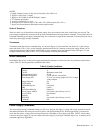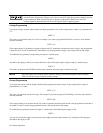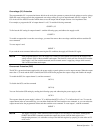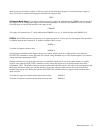
Remote Operation 75
As shown in Figure 5-3, if one or more bits in the fault register of a given output channel are set, then the FAU bit for that
output in the serial poll register will also be set and a service request may be generated (see page 76). To read the fault
register of output 2 and find out which bits are set, send the following query and address the supply to talk:
FAULT? 2
The power supply responds with a number which can be decoded from Table 5-5. For example, the number 9 (8 + 1)
indicates that the OV and the CV bits in the fault register are set.
NOTE If the condition(s) generating the fault(s) is (are) removed but the fault register is not read, the bit(s) in the
fault register will remain set.
The Serial Poll Register. The serial poll register is an 8 bit register which the supply uses to keep track of its internal
operating status and to determine the operating status of each of its outputs. Table 5-6 defines each bit.
Table 5-6. Bit Assignment of the Serial Poll Register
Bit Position 7 6 5 4 3 2 1 0
Bit Weight 128 64 32 16 8 4 2 1
Meaning PON RQS ERR RDY FAU 4 FAU 3 FAU 2 FAU 1
The first four bits (0 to 3) in the register tell whether or not a particular output has a fault. If there is a fault in one of the
outputs, then the corresponding FAU bit will be set. Thus if output 1 has a fault, then FAU 1 will be set. In models with
only three outputs, FAU 4 will always be zero and in two output models, FAU 3 and FAU 4 will always be zero.
The RDY bit is set when processing is complete and is cleared when the supply is processing commands.
The ERR bit is set when a programming or hardware error occurs and is cleared when the error query (ERR?) is received.
The error annunciator on the front panel informs the user when this bit is set or cleared.
The RQS bit is set when the power supply generates a service request and cleared after a serial poll is done (see the
following paragraph, Service Request Generation).
The PON bit is set at power on and cleared when a CLR command is sent.
Service Request Generation
When operating your supply, you may want it to request service every time a fault or a programming error condition
occurs. To do this you send a service request (SRQ) command. When the condition is true, the power supply responds by
setting the RQS bit in the serial poll register, setting the SRQ annunciator on the front panel, and issuing an SRQ over the
GP-IB.
The 662xA supplies can generate a service request for any of the following reasons: (refer to Table 5-7).
• An Output Fault. If there is a fault on one or more of the output channels and you previously sent the SRQ 1 or
SRQ 3 command (see Service Request Enable/Disable information below), then an SRQ will be generated.
• An Error. If there is an error (see Tables 5-8) and you previously sent the SRQ 2 or SRQ 3 command, (see Service
Request Enable/Disable information below), then the supply will generate a service request.
• Power-on. At power-on, the PON bit of the serial poll register is set but the supply will only generate an SRQ if you
previously sent a PON 1 command.
• Input Line Voltage Dropout. Same as power-on condition.


















